#which means that his death isn’t just random. this version was a specially crafted version to ��allow’ for his death
Explore tagged Tumblr posts
Text
also regis swearing at stygga is so meaningful to me because he swore over milva’s dead body and also in front of angoulême (and assumedly cahir too)!!!!!!!!!!!!!!!!

#txt#especially because milva was like… not only his friend but he cared for her medically…#i mean he did for everyone (including cahir and dandelion’s head injuries) but#idk regis seeing her dead when he had saved her life under the bridge and counselled her about pregnancy and abortion#and (i guess it’s headcanon but) when her ribs were broken by the druids and she was healing from that he was there for her#milva was beat up by the narrative but regis was always there with bandages lol#so to see her DEAD completely DEAD with no possibility of healing her#also because *he was off* and he paused for a drink (or two—who knows how many)#of course he’s like ‘fuck this place. i’m going to fuck this shit up’ because how shitty of a surgeon must he feel right now#and if he can’t protect his friends now with medicine well the only other option in his arsenal is Fucking Shit Up#his NOSEDIVE begins early in the halls of stygga castle and he just starts losing it#milva: dies | me: oh… oh they’re *all* gonna die huh…#who knows if regis had returned to the rest of the company and milva was still alive. who knows. maybe he wouldn’t have continued to drink#and maybe he wouldn’t have made that suicidal leap towards vilgefortz in the end#i think that in the loss of the rest of the company regis had nothing left to live for#both from an in-universe POV and from a narrative writing POV#because remember that there were previously written versions in which regis survived and lived#so paying attention to not just when he dies but when he starts to go on this downward trajectory is relevant#because sapkowski intentionally devised a way in which he would die that would be plausible for his character#which means that his death isn’t just random. this version was a specially crafted version to ‘allow’ for his death#i love how AS was like well yeah of course milva and cahir are going to die. but yeah i admit angouleme and regis are just stupid#(to clarify he said angouleme dies stupidly)#but i think saying ‘there were other versions in which the vampire survived’ = this is the version where he is stupid#c: regis#analysis#IN THE TAGS lol#book: lady of the lake
25 notes
·
View notes
Text
Please Don’t Sleep on Hades

2020’s…been a real year, huh? At a time when in-person gatherings aren’t much of a thing and people have to stay in, video games are suddenly a pretty attractive option. That said, few games have really grabbed me this year; in a roundabout way, 2020’s been a year of reruns, as I go through a lot of games I’ve already played or games that are just yesterday’s news (but new to me!). However, in the nick of time, the folks at Supergiant Games delivered unto us their latest title, Hades. While they’ve been working on this game for years, with it hitting Early Access on Steam back in 2018, the full version of Hades finally hit Steam, the Epic Game Store and made the leap to consoles with the Switch, which is where I picked it up. It has been a WHILE since I’ve had a game grab me so strongly so early on, and I’ve been hearing this game’s praises for years now already, so allow me to happily state why I think Hades is worthy of the hype and is a fantastic game I’d easily recommend!
DADDY ISSUES
OK, so first things first…you don’t actually play as Hades in this game, but rather his son Zagreus. Ol’ Zag has had it with his father, and tries to literally fight his way out of hell to reach the surface, and no matter what his old man puts in his way, Zagreus (and the player) will meet the challenge. And probably die, but hey, that’s OK! In the underworld, death is more of an inconvenience than anything else, so after taking a moment to dust himself off, Zagreus will head out for another attempt. For as long as it takes.
Hades is a rogue-like, meaning it’s a game based around randomization and adaptation. On any given “run” of the game, the level layouts, enemies present and the variety of power-ups Zagreus can find will be left to chance, with the player challenged to amass the best build they can to eventually break out of hell and reach the human world and if you die…start from scratch. That said, Hades is among the ever-growing sub-genre of rogue-lites, in that there IS some permanent progression, which takes a bit of a sting out of dying, but more on that later. Now, most games of this type aren’t really big on story. They have a premise that’s little more than an excuse to play. Splunkey wants you to explore a cave, The Binding of Isaac sees you escaping a basement and in Enter the Gungeon you uh…e-enter the gun—you get the point! But what separates Hades from most rogue-likes/lites is that there actually IS a very interesting story that unfolds as you play.
There’s more to Zag’s desire to get to the surface than just getting away from his father, though their strained relationship certainly doesn’t help matters, and over the course of your many, MANY escape attempts, players learn of the rather screwed-up nature of Zagreus’ family of deities, though any mythology nut could tell you to expect that. Hades has an incredibly charismatic cast, superb voice acting across the board, and some real sharp writing that really got me wanting to meet anyone and everyone and learn more about this world. You’re likely to run into Hypnos first, who always has a “tip” ready for you when you meet your end to a given enemy or hazard, or the fabled hero Achilles, who acts as a mentor to Zagreus. There’s Dusa, the adorably frazzled flying gorgon head who acts as the House of Hades’ maid, and of course…Megaera, of the Furies.
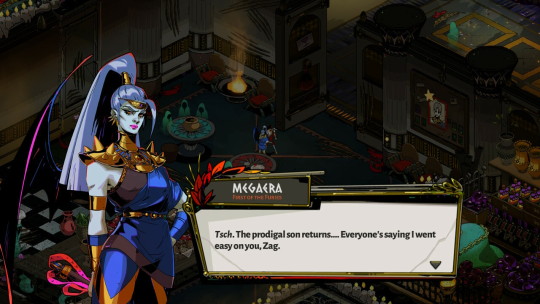
She serves as the first proper boss in the game, and will be a pretty sizable challenge for most players, but as you eventually overcome her again and again, she and Zagreus end up attempting to reconnect with each other, and her recurring fights become an excuse to flirt and test each other. I may as well say too that it’s easy to fall in love with the characters in this game because…I-I mean, just look at them! This game is a bisexual’s paradise, that’s all I’ll say.
A bit of a fun fact, but Zagreus’ voice actor, Darren Korb, is also a composer at Supergiant, so he’s a man of many talents, since Hades has a killer score. From the laid-back tunes at the House of Hades where you can unwind and recharge after a botched run, to the pulse-pounding boss theme, there’s some GREAT music on display here. And that’s before you meet Orpheus and Eurydice, two characters with amazing singing voices that, if you play your cards right, might start singing together. The game’s visuals, meanwhile, aren’t a slouch either. While the level layouts are randomized, everything manages to look well-crafted, each region of the underworld having their own distinct look and feel. The fiery pits of Asphodel end up juxtaposing well with the paradise that is Elysium. Now, character models are generally less-detailed since the camera stays zoomed out to give players a good view of the action, but the portraits for the various characters more than make up for it with their distinct, detailed designs. A-And I’m not just saying that because everyone’s hot! Now, admittedly you might take a look at Zag and think he’s nothing but an edgelord and the game itself might be taking itself too seriously, but in reality, Hades strikes a pretty good balance, and definitely carries a sense of humor. Characters love to snark at each other, the various Shades chilling in the House of Hades’ lounge have some funny conversations you can listen in on and all told, the game only gets serious when appropriate. Really, I have no real complaints with the game on a presentation level; it’s all aces so far, and thankfully the game-y part follows suit!
LIVE.DIE. REPEAT.
Hades is best described as a dungeon-crawler. You have an isometric view as you move about, avoiding hazards and fighting off enemies as you climb each chamber on your way to the surface. Defeat every enemy in a chamber and get a reward. Sounds simple enough until you factor in all of the various permutations of events; Hades aims to make sure no two runs are alike, with different enemies, power-ups and challenges awaiting you. All of this is doled out slowly, as with each subsequent playthrough you begin to have more of the game unraveled. First and foremost, Zagreus can gain various Boons from the other Olympian Gods, who are sympathetic to his plight and lend him some power if he makes contact with them. Each God has their own twist on the abilities they grant Zagreus. They can all increase his stats in some way, or affect either his dash ability or his Cast, a projectile attack. For Zeus, naturally, all of Zagreus’ moves will gain an electric effect, whereas Artemis focuses more on upping Zag’s critical hit chance. Dionysus, the God of Wine, grants you the “hangover” status effect, allowing your attacks to uh…make enemies drunk? Sure! You’ll be given a random selection of three Boons to pick from, of varying rarities. Over the course of a run, you might try to nab as many Boons from the same God as possible, or vary it up and see which abilities synchronize together. At times, you might even be granted a Duo Boon, where two Gods decide to combine their power for a special ability that plays to both of their strengths. Still, at other times, you might be forced into a Trial of the Gods, where you must choose one God’s Boon over the other, with the snubbed God lashing out afterwards. Hey, just because they’re Gods, doesn’t mean they’re nice. Of course, you’ve also got a variety of health and weapon upgrades too. In fact, let’s gush about the weapons for a second, shall we?

At the time of writing, Hades has six weapons to play with. You start with a sword, which is the all-rounder of the set, but as you gain keys to unlock more weapons, you can start to really experiment. The bow and rail cannon serve as ranged options with different approaches, while the spear is the melee weapon with the best range at the cost of pure power. The shield grants you absolute defense at the cost of range, while the gauntlets let you unleash your fisticuffs on underworld scum, though leave you with limited ranged attacks. Each weapon has specific Boons and weapon upgrades you can find as well, some of which can radically alter how a weapon works. The rail cannon, for example, fires a lot faster than the bow, but this is balanced by needing to manually reload…unless you get a weapon upgrade that gives you unlimited ammo with the only catch being that you can only do burst fire. Adding to this, players eventually unlock hidden Aspects of weapons, morphing them into different forms which can also influence their moveset. Change the shield to the Aspect of Zeus, and when you throw your shield Captain America style, it stays out and continually spins, dealing tons of damage over time and effectively forcing enemies to get sliced to bits if they want to get near you. I didn’t expect this game to have half this many weapons or to have them balanced so well. Really, just like anything else, weapons are another tool you can poke and prod and experiment with until you get a truly killer collection of Boons and upgrades that let you just demolish anything in your way. It’s very satisfying when you finally clear a run with a great build…though depending on the RNG, you WILL get some crummy builds, but that’s the nature of the rogue-like!
It’s likely that a bad build (or really, just getting hit with a new boss or enemy you aren’t prepared for) will lead to a death, but as already established, death isn’t really that much of an inconvenience in the underworld. Zagreus just spawns back at home and is free to immediately try to escape again, but this brief reprieve lets you chat up whoever happens to be around, give them gifts, advance some side-quests, pet your dog Cerberus and practice with weapons and such before you’re ready to go at it again. It’s after a run that you also get to spend a lot of the spoils of your escape attempts. While you lose Boons and weapon upgrades and the like upon death, there’s a LOT of various items you keep with you that have plenty of uses. Darkness shards are used for permanent skills that can be applied to Zagreus, like Death’s Defiance, which grants Zagreus another life upon dying, which can eventually be upgraded to give him THREE extra lives, just as an example. Precious gems can be used to fund a variety of cosmetic changes to the House of Hades. Just because Zagreus doesn’t want to live there anymore, doesn’t mean he can’t at least make it look good! Nectar can be gifted to other characters to improve your relationships with them, with bottles of Ambrosia being required later on, while special keys can be used to unlock weapons, more upgrades for your Darkness shards, or just used as a secondary currency for trade. There’s really a LOT of different items to mess around with, though admittedly if you’re the type to want to max out EVERYTHING you’ll be in it for the long haul, as there is not only a LOT of stuff to upgrade and purchase, but the random nature of things means rewards are never a guarantee. Though it’s worth noting the game’s totally beatable without going nuts with completion. Which I guess leads me to the biggest compliment I can give this game: even after “beating” it, I still can’t stop playing, and there’s plenty of reason to keep going.
REPLAYS AND REWARDS
So, full disclosure, I’ve gotten Zagreus to the surface. Several times, actually. But I haven’t quite “beaten” the game yet. In fact, at the risk of sounding pretentious, it is as if the true game begins after you’ve beaten it once. Without getting into specifics, let’s just say the game gives you a very good in-story reason to keep playing, and you won’t reach credits without several completed runs under your belt. And even then, there’s still stuff to do. I’m almost 30 hours into Hades and I’ve barely scratched the surface honestly. Every major character has their own sidequest you can undergo, but it can be slow goings when it comes to advancing them. Trying out all the weapons and boons and different combinations will easily take dozens of hours to fully experience, though the game has a handy in-game list of what you’ve done and haven’t done, as well as in-game achievements with tangible rewards that will spur you on. I was admittedly surprised at how dense of a game Hades can be. A successful run will likely take you somewhere between a half-hour to an hour, which is pretty devious. Just long enough to stay engaging throughout, and short enough that I can keep convincing myself that I have time for “one more run” and then suddenly several hours have gone by. Strangest thing.

Something that’s become a bit of a staple of Supergiant’s work is customizable difficulty, various modifiers you can flip on to make the game harder if you so desire, which in Hades takes the form of the Pact of Punishment. After a successful run, you can turn on a given pact to spice things up for subsequent runs. Maybe enemies do a bit more damage, or you give yourself a super strict time limit to clear a run. You can give enemies armor that makes them sturdier, or jack up the in-game shop’s prices. You can even be forced to give up Boons in order to advance past certain doors! Probably the most impressive Pact is Extreme Measures, which ends up greatly affecting the boss fights in the game…trust me when I say you won’t be ready for them the first time you flip that on. Activating a given pact increases a “heat gauge” that, should it reach a given level, will end up granting you various special items to help with fully upgrading and unlocking stuff. Of course, with each successful run completed with a given Pact activated, you’ll have to raise the heat more and more in order to keep getting these upgrade materials so be prepared. You can also still gain these materials (albeit at a much slower rate) playing through the game normally though, and there’s really no penalty for choosing NOT to activate a given pact. On the flip side of things, there’s also a God Mode you can toggle on that makes Zagreus a little stronger with each death, which can help those that want to see more of the story but are struggling with the game. Have your God Cake and eat it too!
All and all, this game just delivers on every level and I’ve been devouring it since release whenever I have a spare minute. You can see that Supergiant is taking all the lessons they learned from each previous game and combined it to make what is easily their best game yet. I don’t throw around words like “masterpiece” lightly, but Hades is just such a slam dunk that I’m sorely tempted to call it just that. I mean, if you hate rogue-likes, I’m not sure if Hades will really push you over the edge admittedly? You get way more rewards retained after death than just about any other rogue-like I’ve played, but if you’re the type that hates having to constantly adapt and not being able to memorize what’s coming, I can see this not working for you. But for me at least, I’ve had an absolute blast with the game and the only issue I really have with it is a small nitpick at best. When it comes to getting to know various characters, you can talk to them and give them Nectar or Ambrosia as a gift right? But what happens if they don’t show up on a given run? Or what if they DO show up, but they’re locked into a conversation with someone else? That means you can’t really advance anything with them until a given dice roll pities you. MEGAERA I THINK YOU’RE COOL, PLEASE JUST TALK TO M—oh sorry, don’t know where that came from… So yeah, that’s the nittiest of picks.
I adore this game’s cast, the voice work and music is excellent to the ear, the combat is engaging, the gameplay loop is addicting…need I say more? I mean, I’ve said almost 3000 words, but to really sum it up…I highly recommend Hades and I hope you don’t pass it up if you’re even remotely interested. You can find it on Steam, the Epic store and Switch as of right now, and I don’t think you could go wrong with any version.
Blood and darkness await you.
-B
#Hades#Hades game#supergiant games#hades supergiant#zagreus#megaera#rouge like#nintendo switch#xb-squaredx
7 notes
·
View notes
Text
Dragon Warrior/Quest ramblings/collective review
I rant about the Dragon Quest franchise a lot.
Two of my video game pet peeves are when people laude the original Dragon Warrior/Dragon Quest as ground breaking (it’s not, see Wizardy/Ultima), or the great grandfather of JRPGs (it’s not, see Hydlide/Dragon Slayer/Fantasian/) I’m generally not a fan of silent protagonists. I rarely identify enough with a character to feel like I’m “in” the game, so I prefer to be playing the role of a character with some kind of dialogue and a personality. Every dragon quest (that I’ve played) has a silent protagonist. That said, I do have some love for the series. I’ve suddenly found myself interested in giving Dragon Quest XI a spin, but instead I went back to Dragon Warrior IV. I remembered liking it as a kid and I’m happy to say I’ve been having as much fun playing it now as I remember having back then. Here are my thoughts on the dragon quest games separated into the ones I’ve finished and the ones I haven’t (mainline only).
Games I’ve Finished
Dragon Quest: This is grinding the game.
Strategy is almost nonexistent in the battle system outside of “Grind XP to LVL UP/Gold to buy better equipment”. You have 1 character and you never fight more than 1 enemy, so all fights are one-on-one. There isn’t any equipment with special traits or functions (just better Attack/Defense). You get access to a total of 6 spells in the game: Heal Heal More Heal Most Hurt Hurt More Hurt Most (these last 3 are usually a waste of MP) The plot is linear (except for potentially at the very end of the game). At least there’s a decent amount of exploration. Worse than Final fantasy I and Phantasy Star I by far, but to be fair, Enix did better with Dragon Quest II, which beat both of these competitors to the punch. Dragon Quest II: So much better than the original.
The grind is mediated by choices that matter in regards to equipment and combat. Also, you have an actual party this time (of 3), Also, Also, you can fight multiple enemies at the same time. Dragon Quest II added a much wider variety of spells (buff, debuff, and elemental damage spells); Equipment that had special functions when used as an item in combat (e.g. the Lightning Staff can cast whoosh), and a smidge more plot. Many people say more grinding is required in II than in the original, but I would argue that Dragon Quest I is nothing but grinding whereas Dragon Quest II breaks up the monotony with a dose of strategy. Comparable to Final Fantasy I. Far worse than Phantasy Star I. Dragon Quest V: Decent.
Also the first game originating on the Super Famicom (although we didn’t get an official English translation till the DS remake)
Allows for a party of 3 (4 in the DS remake). Considered groundbreaking by many for it’s monster recruitment system but it wasn’t the first game to have one by any means (Megami Tensei beat it by 5 years and Wizardry IV by 4). The game is divided into sections based on time periods as you grow from a kid to a teen to an adult, which is a cool way of pacing the games content, and gives you a little more perspective on the setting than you typically get in a Dragon Quest game. Characters are mostly boring outside of one (or two) of the love interests. Did I mention this game has love interests? I think I would have liked it better if there was only one, because it punched me in the heart for not picking the one it leads up to as the primary love interest (who also happens to be the canon one). Has really frustrating setting/plot-gender dynamics with two characters late in the game who I won’t name because spoilers.
Games I’ve Played but haven’t finished
Dragon Quest III: My least favorite game in the series (out of the ones I’ve played).
This time you have a protagonist and you can hire adventures to join you on your quest. They are all nobody characters. Their personalities are assigned at random, and (from what I can tell) only effect their growth. There’s no fucking dialogue with them (which is something I expected after DQ II). Personalities and seeds are fucking annoying, because both of them are random, have huge differences in their effects, and their effects make a huge difference in character capabilities, so it makes me want to spend hours saving/reloading until I get the effects I want. Fuck this game for introducing seeds to the series which appeared in many Dragon Quest games after this (thankfully I haven’t run into personalities again yet). Often lauded for having the “groundbreaking” option of changing character classes/jobs. Yes this came out before Final Fantasy III (Japan), but I would like to make the following points: - Final Fantasy I let you pick your character classes (which came out beforehand) - Final Fantasy III had a class change system you could actually make use of throughout the game (unlike DQ III where you need to get about halfway through the game first) - The original Wizardry came out 7 years earlier and also had a much more accessible class change system than DQ III I played very little of Dragon Quest III (I dropped it before even getting to my 2nd town). Two great thing about this games: It’s the first in the series to give you the option of playing as a woman, and I heard it’s the game that introduced the casino/mini games to the franchise. Dragon Quest IV: This game is Great! Also, Unlike the first three games in the series, Dragon Quest IV might actually be groundbreaking. You ever play Wild Arms I, II, or III? Did you enjoy playing through the prologues that introduce your early party members? Well Dragon Quest IV does a similar thing: The game is divided into chapters. Each chapter has a different protagonist. In their chapter you play them as silent protagonist, but when you encounter them later in the game they have dialogue. This does a lot to develop much of the cast, because you can see how people react to/talk with them and later on you can see how they engage with the player character (who you’re actually introduced to last). The cast is great and falls into a mix of both very old school and very uncommon tropes for a JRPG: You have an aging knight who goes on a mission to rescue children and then goes on a journey to find more about the ominous forces behind their kidnappers (Ragnar). Then there’s a princess who wants to go on an adventure against her fathers wishes so she kicks a hole in the wall of her room and jumps out of the castle (Alena); she’s joined by a young priest (Cristo) and an elderly mage (Brey) employed by her father, who give up on bringing her home and instead ask to travel with her to help her out. Next you have a merchant who wants to raise enough money to buy his own storefront (Taloon). After that you play a Fortune Teller (Nara) who travels with her dancer sister (Mara) on a quest to avenge the death of their father (an alchemist who was murdered by his apprentice). Each chapter ends on a climax related to motivations/goals of its lead character and each chapter shows more of the world/gives out more info on what is going on behind the scenes. While you actively control the primary characters of a chapter other characters are either controlled completely by AI (in chapters I-IV), or loosely follow a tactical strategy you select (chapter V). I’ve been getting on fine with it, but this might be a deal breaker for some. The music is better than any of the Dragon Quest games I’ve finished (and what I’ve heard from any of the ones I’ve played, but not finished). A remake of this game has an interesting flaw: they cut all the party chart dialogue from the foreign language versions of the DS version; so if you don’t know Japanese, you’ll probably miss out on a lot of character interaction with that version. (I heard this had something to do with concerns that the game wouldn’t make enough sales to cover translation costs of the party chart [which was reputedly two thirds of the game’s script]). Dragon Quest VI Honestly I’ve barely played this one. You have actual characters for party members (a big plus in my book). I’ve heard there’s a job system as well. Plot/setting seem decently interesting on first glance. I might come back to this one later. Dragon Quest VIII I got about halfway through this one.
They included a character-specific skill tree system which is cool, except that there are objectively best routes to take for some (possibly all?) characters and these best routes are not even close to obvious from the outset. It introduced a pretty fun crafting system.
There’s a decent cast of characters, but they don’t have quite enough going on for my tastes (my fave is Yangus). Plot has an interesting premise, but feels very barebones, and the environments/towns/npcs aren’t very interesting (maybe about as good as DQV, but worse than IV).
This game gets lauded for the 3D models of characters/enemies, but honestly I’ve never been a fan of the character designs of Dragon Quest (especially the monsters), so I feel pretty “meh” about it outside of being able to see your party members in combat (for I think the first time in the series), which is very nice. The music is very ambient a lot of the time. It does a good job of fitting melancholy moments, but doesn’t do such a great job of building excitement during battles and high-tension events. Dragon Quest IX This game feels a lot like Dragon Quest III.
You don’t have any actual characters, you just recruit them and use them in battle (no meaningful intraparty dialogue, character development, etc.) I think I played around 10-20 hours before dropping it.
Final Thoughts
Dragon Quest games vary from game to game in terms of gameplay mechanics, but they vary a great deal more when it comes to characters.
If you like having a lot of control over your party composition and don’t care about having characters with personality, you might like Dragon Quest III, V, or IX.
If you want a party comprised of characters who interact, have personalities, and might even develop over time, you might like Dragon Quest IV, or (sort of) VIII (I haven’t played much of VI, or any of VII or XI, but I heard they also fall into this camp). If you want to play an old school, 8-Bit JRPG that launched a spectacular franchise, might have actually been ground-breaking for its time, and is still fun to play today, check out the original Phantasy Star. . . . . . . (at least, for me it’s still fun to this day) [notes: - edited some typos, and mistakes most notably regarding the Hurt series of spells in Dragon Quest I - Revised some word choices - Added a comment about being able to see your party in combat in Dragon Quest VIII]
#Dragon Warrior#Dragon Quest#Dragon Warrior IV#Dragon Quest IV#Dragon Quest II#Dragon Warrior II#Dragon Quest III#Dragon Warrior III#Dragon Quest V#Dragon Quest VI#Dragon Quest VIII#I'm generally not a fan of silent protagonists
7 notes
·
View notes
Text
Mezzo Plays Final Fantasy X: Part 14
Yuna and crew are still trying to think of ways to defeat Sin without using the Final Aeon.

They're not coming up with much.
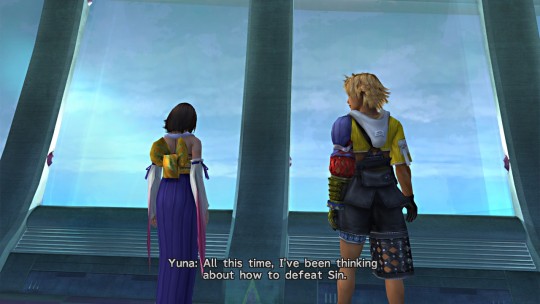
Yuna is distraught because apart from the teachings of Yevon, she knows nothing.

Kimahri has a good idea, though.

Back on the bridge, Wakka, Rikku, and Lulu share their thoughts. Sin was calmly listening to the Hymn of the Fayth in Macalania, so they may be able to render it docile using that.

Our next destination is heading back to Bevelle to talk to Mika, but there's a lot that can get done before then. With the airship we can now travel to anywhere in Spira. Backtracking is finally unlocked!
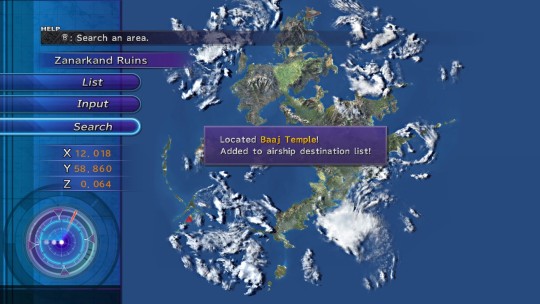
You can search for hidden areas too, like this secret temple. It's actually the one Tidus was abandoned in way back at the start.
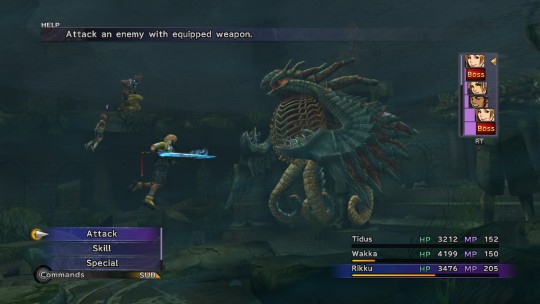
Which means this guy's here too, and now we get to fight him for real. He's vulnerable to magic, which would be great if Lulu or Kimahri were here. Since they aren't, we have to rely on Rikku's items for that.
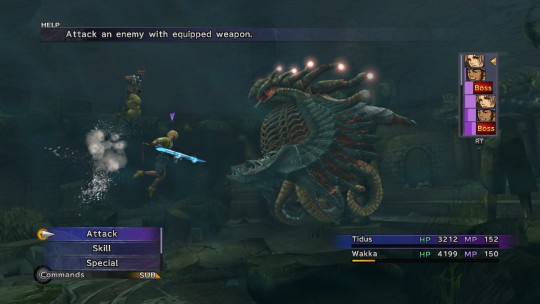
...Or not. The boss has a petrifying punch attack, and if a character is turned to stone underwater, they sink and shatter immediately.
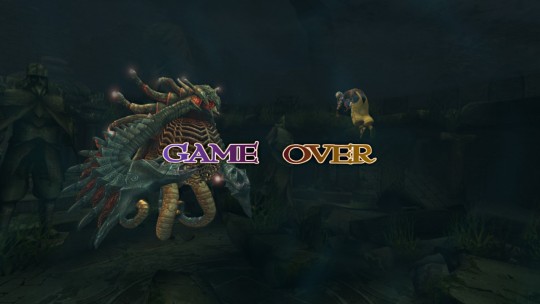
Yeah, it's kind of unfair.

I eventually managed to beat him with solo Wakka. His Evade + Counter ability kept him safe from being turned to stone, and the fiend's only other attack was to swallow him whole, then spit him out on the next turn.
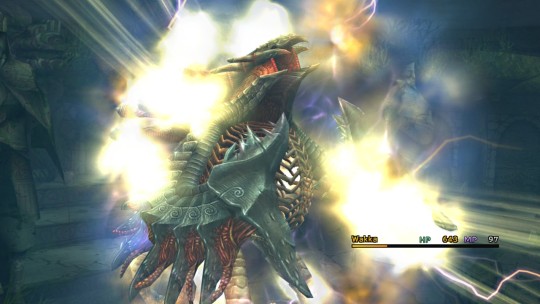
What a hassle.

Inside the temple lies a fayth, but it's blocked by a seal. You need all the Destruction Sphere treasures from the temples to break it. We're missing one, from the temple in the Zanarkand Ruins. You can't pick that one up the first time you go through. Thanks to the airship, getting back there is no problem at all.
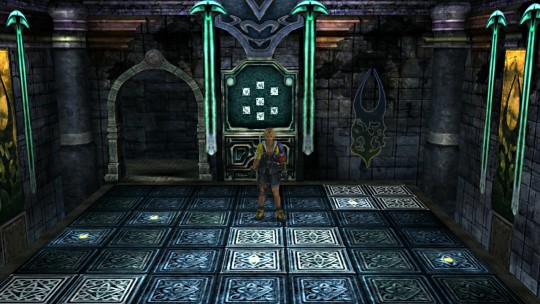
First we need to activate the white squares to reveal a Destruction Sphere, then install it into the screen to reveal the chest.

This weapon for Yuna has a really nice trait: it reduces all her MP costs by half.

Once that's done, the chamber is open. This fayth looks pretty familiar.

It's Seymour's mother.

As she explains, she became a fayth so that she could be with him always, but it unlocked a lust for power within his heart. She now allies with Yuna in the hopes that she will destroy Sin, and her son's obsession with it.

This aeon's name is already known, but I'm going to rename her anyway. The dark aeon deals out death and pain, so naming her after the god of death isn't a bad idea at all. Credit to Keys for the name.
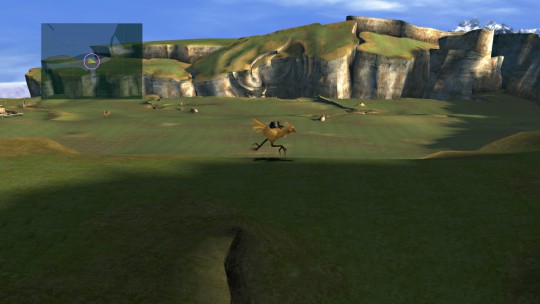
More errands to take care of. Heading back to the Calm Lands, there's now a guy offering rental chocobo rides. While on chocoback you move much faster and don't have to deal with random encounters. You can also jump at certain ledges where a chocobo feather lies, leading to...

The hidden temple of Remiem. Belgemine mentioned this place the last time we saw her.
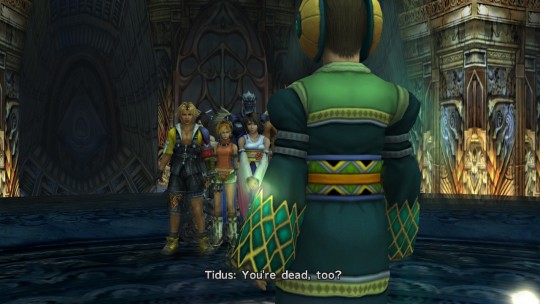
She is here, and she is revealed to be an unsent. Before Yuna sends her, she asks of her one thing: A final duel of aeons, with her using all of them in sequence.
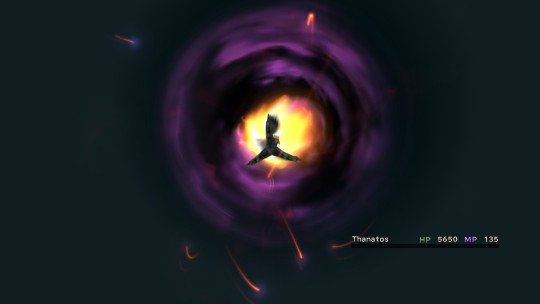

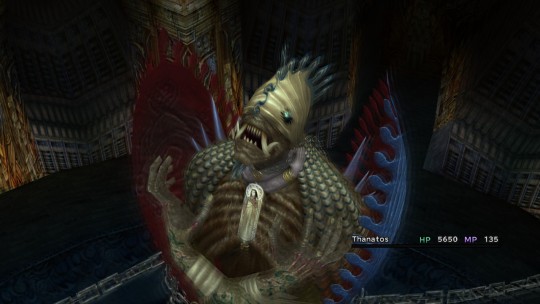

Much like when Seymour used her, she has the Pain special that deals damage with a chance to instantly kill, and that already breaks the damage limit on its own. She also has access to the full library of black magic spells, plus Bio and Death.

And now we get to see her Overdrive in its full glory.
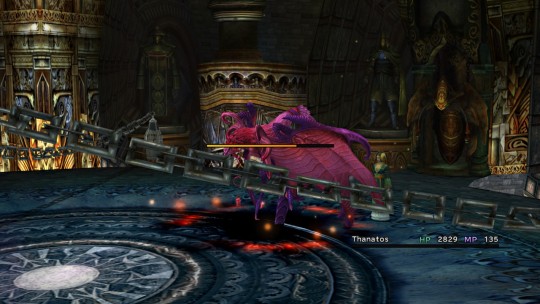
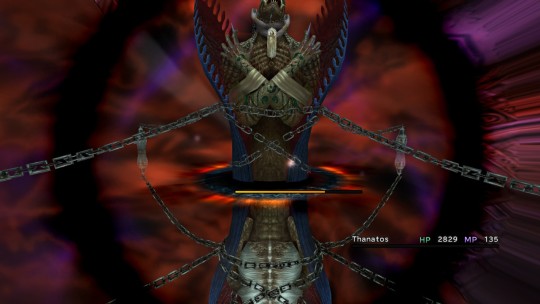
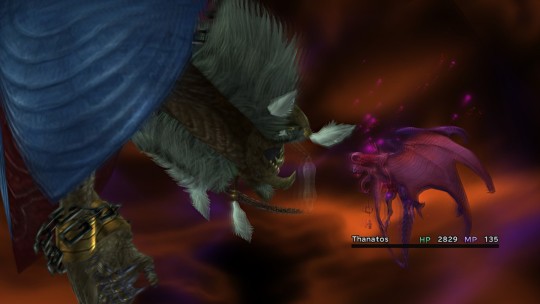

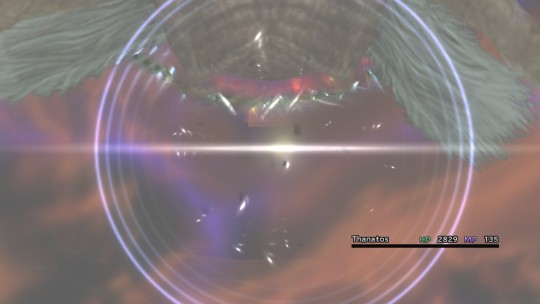
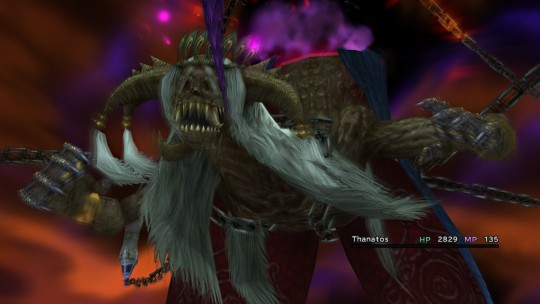

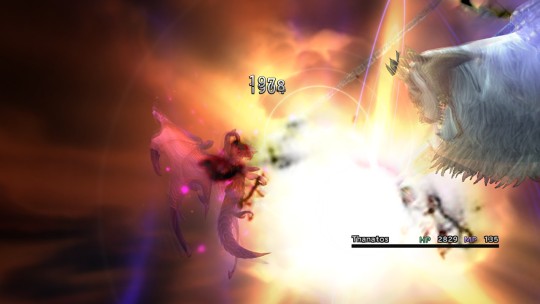
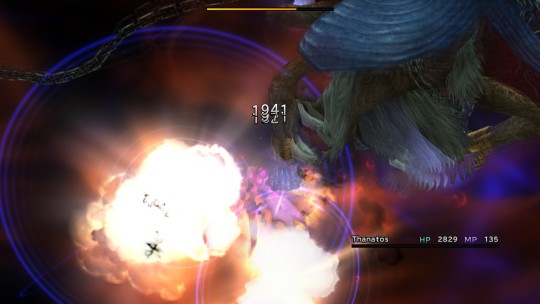

This deals out 12 hits total. It's hard to say exactly how much damage it deals total, aside from 'a lot'. Belgemine's Valefor didn't stand a chance.

There's another fayth here too, but the door to the chamber is sealed by a mysterious force. Two keys are required to unlock it. Belgemine has one, the Flower Scepter, and she rewards Yuna with it as the prize for defeating her Bahamut.

The other is held by the monster arena owner. First we need to capture one of every species in the Calm Lands. This is long and grindy and honestly I'm just gonna skim over it because it's annoying. Adding petrification or death to a capture weapon works quite well, as it will instantly one-shot and capture the target on hit.
Once we've collected every fiend type in the Calm Lands, we need to do that again for Mt. Gagazet, and the Blossom Crown is ours.



These aeons are a trio, and are collectively known as the Magus Sisters. The names were another suggestion from Keys, and apparently come from the Fate franchise. In any case, they're way better than the canon names, which are Cindy, Sandy, and Mindy respectively.



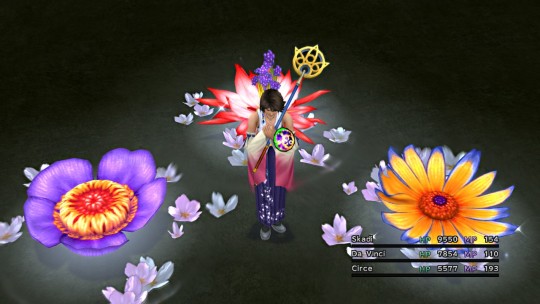
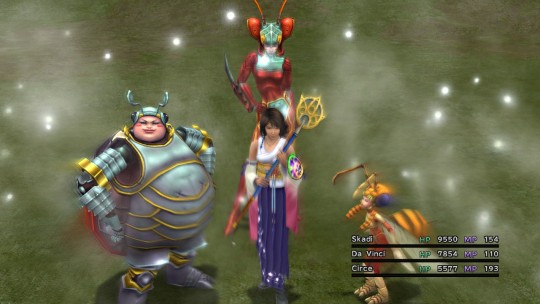
They may look silly, but they're incredibly powerful. Rather than controlling them directly, Yuna offers suggestions on what they should do this turn, and they may or may not follow through with it. Considering how effortlessly they can break the damage limit, it's not a huge drawback. Each sister has her own special: Skadi's Camisade is a flying leap, Da Vinci's Razzia attacks with blades of fire, and Circe's Passado is a multi-hit attack from her stinger.

They use their Overdrive as a team, and all three need to have full gauges to activate it.




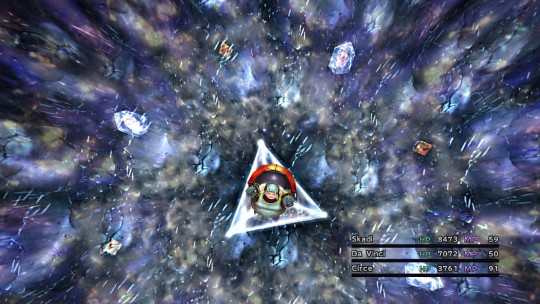






This is the most extravagant battle animation in a game that's full of nothing but the most extravagant battle animations. It deals 6 hits total, and much like Oblivion, it's hard to tell exactly how much damage it does, but it's a whole lot of pain.
While I was off grinding through the capture sidequest, I also took the time to get everyone to the end of their individual Sphere Grid paths. Each path is capped off with a final ability.
Tidus: Quick Hit. A standard attack with fast recovery time, allowing his next turn to come sooner.
Yuna: Holy. The rare offensive white magic spell, this summons pearls of holy light to smite the enemy.
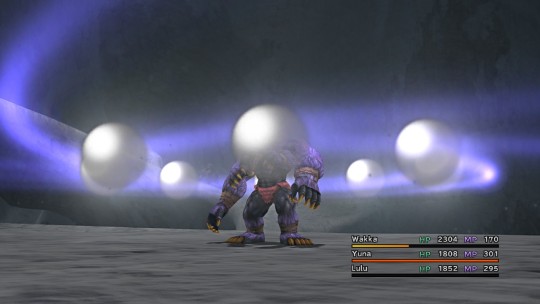

This hits 9999 damage easily, but has a ridiculously high 85 MP cost. The Half MP weapon we found for her helps offset that a lot.
Wakka: Triple Foul. An attack that causes all three of blindness, silence, and sleep, basically combining all his debuff skills into one.
Lulu (and Kimahri): Flare. We already saw Seymour cast this spell, but it's real nice to have it on our side too.

Fun fact: In the original Final Fantasy, this spell was called Nuke. It's an apt description. Like Seymour's version, it looks like fire but actually deals non-aspected damage.
Auron: Sentinel. Allows him to guard allies while also reducing damage taken.
Rikku: Bribe. Pay gil to enemies to make them go away. It doesn't seem all that great, but bribed enemies will leave behind very rare and valuable items. The gil costs can get absurd, though.
After our errands are out of the way, it's back off to Bevelle.

Shelinda orders the soldiers to stand down. She says that the rumors of Yuna being a traitor are lies spread by the Al Bhed. Rikku's not happy about that, but it does work as a convenient excuse to gain an audience with Maester Mika.
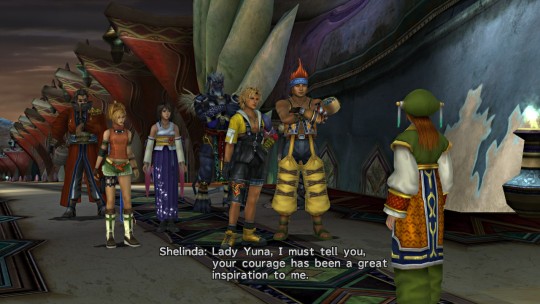
Yevon's in a bit of chaos right now, but she's standing strong.

Mika is very unhappy about what Yuna has done. With no Final Summoning, there is no way to defeat Sin, or so he believes.

And who is Yu Yevon? Mika offers a few more details: he is one who crafts the souls of the dead into unholy armor, an armor named Sin. Shortly after, his shock causes him to fade into nothingness. Shelinda appears again, and asks where the maester is. Auron says he isn't here yet, allowing the party time to escape.

The fayth child appears again, and beckons Yuna to their chamber. They explain that after an aeon destroys Sin, Yu Yevon takes it over and makes it into the new Sin. Thus, to truly break the cycle, they need to venture inside of Sin and kill Yu Yevon himself.
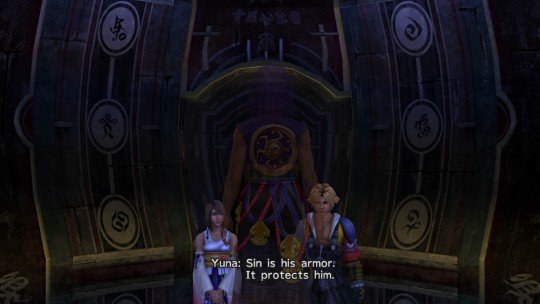
It protects him while he continues his summoning. But what exactly is he summoning? A dream.

And if they destroy him... well, things don't look very good for Tidus.
Before leaving Bevelle, the group gives Shelinda a message to send to everyone in Spira. "A ship in the sky will sing the Hymn of the Fayth. When it does, sing along."
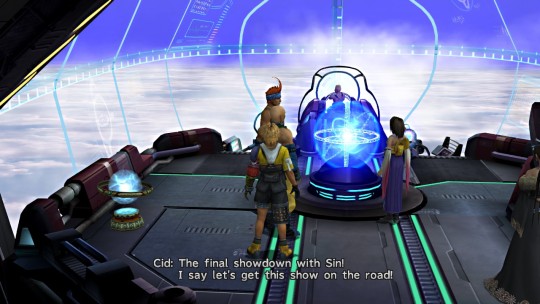
Everything is in place, and the final battle is nigh.
3 notes
·
View notes
Text
Artoria Caster Analysis
Arts is inevitable
Artoria Caster Max HP: 14,406 Max ATK: 10,546 (Effective ATK: 9,491) Star Attribute Star Absorption: 50 Star Generation: 11% NP Charge ATK: 0.54% NP Charge DEF: 3% Death Rate: 36% Traits: Arthur, Humanoid, Saberface, Servant
QAAAB Quick = 3 hits, Arts = 3 hits, Buster = 3 hits, Extra = 5 hits Quick = 1.62%, Arts = 1.62%, Extra = 2.70%
Charisma of Hope B Increases party's attack for 3 turns. (10 -> 20%) Charges party's NP guage. (20 -> 30%) Cooldown: 8 -> 6 turns
Protection of Vivian A Charges one ally's NP gauge. (10 -> 20%) Increases party's NP generation rate for 3 turns. (20 -> 30%). Cooldown: 7 -> 5 turns
Caliburn: Sword of Selection EX Increases own ally's Arts performance for 3 turns. (30 -> 50%) Increases their damage against Threat to Humanity enemies for 3 turns. (30 -> 50%). Grants them Invincibility for 1 turn. Cooldown: 8 -> 6 turns
Magic Resistance A: Increases own debuff resistance by 20%.
Territory Creation EX: Increases own Arts performance by 12%.
Independent Magic B: Increases own critical damage on Arts cards by 10%.
Around Caliburn / Round of Avalon Arts Increases party's Attack for 3 turns. (30 -> 50%, NP Level) Removes party's debuffs. Grants Party Anti-Purge buff for X times, 3 turns. (1 -> 5 times, OC)
Primary Role: DPS support, Defensive Support
You probably have heard about ten thousand viewpoints on how good Artoria Caster is, and I'll be honest, I'm probably not going to bringing too much unique to the table here. It doesn't take a genius to see how powerful Caster Artoria is, being by far the best Arts support in the game and having great generally usability as well. No matter how you feel about the existence of a meta in F/GO, it's pretty hard to argue that she isn't game-changing.
Starting from her fundamentals, you might find that's she actually isn't amazing in that regard. Her statline is positioned well enough, having high HP and a lower ATK, which is good for what she does, but her NP Generation leaves a little to be desired at first glance. Her Quick card is also pretty much useless, as she won't generally make many crit stars no matter what her chain, with a maximum of 12. Her AAA chain will generate 55% of her NP gauge on average, which isn't bad since having a natural Arts chain is always useful. If you use her 2nd and 3rd skills, she can charge her NP gauge to max in one turn, although she will only generate 79% of her gauge for the next two turns, since she needs the 20% charge. All things considered, her NP generation is perfectly fine, thanks to her skills. It just looks more mediocre on its own. Similar to Merlin in all honesty.
Going onto her skills, they're all amazing. She has a better version of Merlin's 1st skill, generating more NP but coming at the cost of an extra turn of cooldown. She also now provides the largest party wide NP gauge charge on a skill, which is quite notable, although going from 20% to 30% is a bit situational in terms of the difference it makes. Her second skill provides a targeted charge and a party wide NP gen bonus, and while Nero's targeted charge is bigger and her targeted NP gen is also larger, this skill is very synergistic with Artoria's kit, providing a 50% NP charge to one Servant. Her final skill is a 50% Arts steroid that also boosts damage against a pretty specific niche of enemy, and to top it all off it's also a targetable Invulnerability too. All on a 6 turn cooldown. These skills make Artoria the best Arts support in the game, not only providing both NP Generation and Arts performance, but very strong NP charges on top of it.
Her NP is also extremely good as well. It provides a strong Attack boost that gets even better with extra NP levels, removes all debuffs from the entire party, and provides a special Anti-Purge buff, which is Invulnerability but also ignores Pierce Invul. She even provides extra hits per OC level, for a maximum of 5 hits of Anti-Purge for 3 turns. It's a really good NP since all of its effects are very good, and even sticking it at the end of an NP chain gives what is essentially a super Protection from Arrows effect. She fits incredibly well into defensive teams because of it, able to protect the party from damage unless the buffs get removed. This NP is even good in Arts teams who typically had problems dealing with NP damage if a boss could instantly charge their NP.
Support Options: Artoria Caster is more, the support to other Servants and not really a Servant who really requires supports in any way. Using Double Artoria will turbo-charge a big number of Arts Servants, allowing them to do a ton of damage and get a ton of refund from their NPs and basic Arts cards. Tamamo is very synergistic as well, since she provides healing which is something that Artoria Caster also lacks. Servants who provide Buff Removal resist, such as Murasaki Shikinu or Beni-Enma can also provide the perfect defense set-up where it becomes impossible to deal damage once Artoria uses her NP. Medea Lily provides both healing and buff removal resistance to a more defensive team as well, in addition to some Debuff resistance.
Command Code: Artoria doesn't require Command Codes at all to function, so there main recommendations are Command Codes that will allow her to support the team, either through specific buff removal, generating critical stars, or boosting party crit damage. She will work just fine without any Command Codes though, so you can skip over her.
Craft Essences: In an Arts team, Castor Artoria typically doesn't need specific CEs. Looping teams can use her with a CE that boosts QP, Master EXP, MC EXP, or Bond points since they won't typically do much in the way of attacking. More defensive Arts teams can use Arts boosting CEs, Prisma Cosmos, or starting NP CEs in order to get to her NP faster or on demand, and stall teams will enjoy Prisma Cosmos or Maid in Halloween. Her Bond CE can also be used effectively as well. If you want to stick her with a Servant that wants to crit as well, Fragments of 2030 is recommended, since she cannot generate crit stars well on her own.
Competition: Caster Artoria doesn't have competition per se, she's at the top of the food chain. But it's worth comparing her to Tamamo and Caster Gilgamesh specifically. Tamamo is more defensive and works better in longer battles, providing healing and skill cooldown reduction, and Caster Gilgamesh is far better with Art Crit servants since he boosts their crit star generation, and can do a good amount of damage on his own. Paracelsus isn't competition per se but is often the 3rd Arts support in a looping team.
Jeanne occasionally is better in stall teams thanks to her Stun, and Ruler advantage against Riders, Moon Cancers, and Alter Egos, but she's generally worse than Artoria in the stall department.
Pros: -Incredible support kit that activates pretty much every Arts servant in the game -Double Artoria presents some of the cheapest looping set-ups in the game -NP is incredibly powerful -Great general use thanks to large NP charge numbers -Is very cute and her smile cures cancer
Cons: -Provides no crit support what so ever -No healing or defense buffs means she's more frail against normal attack damage -3rd support isn't as cute or good as 1st or 2nd and if you're using random Ascension options that can be disappointing, at least to me personally I love her 2nd ascension outfit
Artoria Caster is, at least in my eyes, probably the best Servant in the game at this point, but it's worth keeping things in perspective for a moment. She massively boosts Arts as a playstyle, but both Buster and Quick are still very viable and have different pros and cons compared to the Arts playstyle. She's not perfect either, she just provides something that no other Arts support has in the past: a lot of NP charge. That's enough to really equalize the Arts playstyle and allow a ton of Servants to function far better than they have in the past. She is game changing though, and definitely the first immense hit of powercreep the game has had in a long time.
All hail the Arts overlords.
1 note
·
View note
Text
The Best iOS & Android RPGs
The best RPGs are ones that offer unique environments, well-rounded/written characters, and unusual, original plots. Some of these games are more action-oriented while others are strictly turn-based, but they all have distinct, immersive visions in which the player might find their own ego subsumed, for a time, as deeply as is desired.
Below is not only a collection of great games, but they're also paragons of the genre and represent ‘role-play’ at its finest whether you're playing on Android or iOS.
What are the best iOS and Android RPGS?
Pascal's Wager
Battle Chasers: Nightwar
Star Traders: Frontiers
Demons' Rise
Planescape Torment: Enhanced Edition
Star Wars Knights of the Old Republic
Legend of Grimrock
Baldur's Gate: Enhanced Edition
Chrono Trigger
Titan Quest
Transistor
Final Fantasy IX
Pascal's Wager
Developer: Giant Network Platform: iOS Universal, (Android Coming Q2 2020) Price: $6.99
A more serious attempt to pose the "What if Dark Souls but mobile?" question, Pascal's Wager is every bit as grim and gritty as the iconic murder-RPGs of console and PC. It's 20 hours may seem quite modest by console standards, but is a pretty decent slog for mobile gamers and it offers up some very challenging and rewarding gameplay. It swaps an open world for more enclosed areas, which makes travelling around a bit easier although you may need to back-track every now and then.
You should read our Pascal's Wager review for more.
Battle Chasers: Nightwar
Developer: Handy Games Platform: iOS Universal, Android Price: $9.99
It took as a while to get a review of this out the door, but it was well worth the wait. This indie darling has proven very popular amongst the PC crowd, and with it's slick performance, engaging turn-based tactical mechanics and engaging narrative, it's no surprise it was a hit with us as well. It's a little on the pricier side of but well worth your money if you're looking for a fully-fleshed out RPG experience with all the trimmings.
Not much more to say about it beyond that - you can check out our Battle Chasers Nightwar review for a more comprehensive verdict but this is a pretty good RPG that's been expertly ported to mobile, and we're all the better for it.
Star Traders: Frontiers
Developer: Trese Brothers Platform: iOS Universal, Android Price: $6.99
One of 2019's best releases so far and an excellent addition to the RPG roster, Star Traders: Frontiers is the culmination of nearly a decade's worth of effort making quality premium games on mobile. You customise your captains and your crew and sail amongst stars trying to eek out a living in a hostile universe. Trade, go on missions, fight pirates and aliens... this is a very diverse sandbox RPG in space, and an excellent port of the original PC version.
The only thing to keep in mind when jumping into Frontiers is that there's a lot to consider all at once, and the openness is almost intimidating. There are some tool tips and an initial main quest that will teach you some ropes, but beyond that one criticism is that its not very good at explaining itself. Still, trial and error is not the worst thing and the more you learn, the more fun you'll have as you explore all the different play-styles and gameplay options. On top of that, the developers are constantly updating the game with free content, so you'll be well served in the future.
Demons' Rise
Developer: Wave Light Games Platform: iOS Universal, Android Price: $7.99
This dark fantasy, turn-based RPG is a favourite amongst PT staffers, and the sequel reviewed very well when it came out. Even three years later, it still manages to draw new players with its deep approach to tactical combat, and it's D&D-style treatment of the game world. While there's an argument to be made that Demon's Rise 2 should also be on this list (either in addition to, or instead of), which one you end up picking up you're not going to regret your choice.
Fans of tactical RPGs, Dungeons & Dragons, and MMO-style combat will really take to the campaign and won't regret adding this game to their collection.
Planescape Torment: Enhanced Edition
Developer: Overhaul Games Platforms: iOS, Android Price: $9.99
Planescape is strange and idiosyncratic, its characters ranging from a chaotic fire-lord whose passion is simple, total consumption and destruction of the world around him to a cherub from the Brothel for Slaking Intellectual Lusts. Its take on a D&D system isn’t particularly balanced, for the stats and character builds favor wisdom above all, both in terms of raw bonus experience and the extra interactions and dialogue options. But the story is to die for.
The multiplanar quest of an immortal, tormented, amnesiac main character to know thyself is at once alien and deeply human. Enjoying this pre-millennium classic before its enhanced edition debut last year meant overlooking a multitude of practical shortcomings; the non-scalable and at times grainy graphics, to say nothing of bugs and lost content. Now one can meet the protagonist and experience his joys and sorrows with ease, if not comfort. The game’s peccadillos are entirely the point, its strange, singular vision undimmed by age.
Star Wars Knights of the Old Republic
Developer: Aspyr Platforms: iOS, Android Price: $9.99
In a galaxy far, far away, in a distant time immemorial, the Sith and Jedi wore very different masks. To make something as nostalgic and cherished as Star Wars new again, BioWare and LucasArts flung their players millennia into the past and pitted them against Darth Malak in a struggle for the fate of the galaxy.
The characters remain iconic and memorable to this day (HK-47 as a murderous, seemingly punctilious droid, for example), and the now-standard paragon-neutral-renegade trifecta of alignment-based decision rubric for RPGs was a natural fit for the Star Wars mythos. Choose light or dark, good or evil: these archetypes resonate because they work, as does the class- and skill-systems which were tweaked from the paper RPG baseline.
Legend of Grimrock
Developer: Almost Human Platform: iOS Price: $4.99
What is Grimrock? Four prisoners marked for death are flung into the heart of an ancient mountain to see trial by the elements. By delving deeper as a party, defeating the enemies and unravelling the riddles, you will overturn your sentence and start afresh. The mysteries of the game’s titular dungeon, whose design indicates was intended a prison for a multitude of strange beings, mount with each level until the mother-horror is finally met on the deepest level.
An old-school game with grid-based real-time combat, riddles, puzzles, traps and hand-crafted (read: non-procedural, non-roguelike) levels. Good looking and thoughtfully made, its battle pace and minimal input requirements make it a natural fit for mobile. Read our Legend of Grimrock review for more.
Baldur's Gate: Enhanced Edition
Platforms: iOS Universal, Android Price: $9.99
D&D spent a long time banished to the corners of a select few lives, shining for hours at a time in small gatherings held regularly among the elect. There have been many implementations of the various settings and rule systems of the original grand-daddy of pen-and-paper RPGs, but Baldur’s Gate is perhaps the most significant and enduring of them all. (Sorry, Temple of Elemental Evil and friends, close but no cigar).
Read our Baldur's Gate review for more.
Chrono Trigger
Developer: Square Enix Platforms: iOS Universal, Android Price: $9.99
A journey for the ages, with a motley crew visiting each era to repair the mistakes of the past and break other timelines, zig-zagging across character arcs and plot holes with aplomb. The RPG elements are just as great as the story, both of them equally...timeless. And the soundtrack is nuanced and varied, with mysterious, mournful threnodies as well as rousing boss-battle hymns. The game keeps popping up everywhere, and for good reason, for its characters, music and story both exemplify the JRPG genre and somehow transcend it. Chrono Trigger is Chrono Trigger; to play it involves learning about RPG conventions and mechanics but to experience it is so much more, a different creature altogether.
Titan Quest
Developer: THQ Nordic Platforms: iOS Univeral, Android Price: $6.99, $8.99
A diabolic, pan-Hellenic action-RPG whose loot system and mythic references have earned its place in the pantheon. See the world, from the Aegean to Bosphorus, to the Nile, slay its beasts of prominence. At the time of its release in 2006, the game seemed redundant and derivative; now it shines in a mobile market where a premium game with fascinating, nay, compelling, rich pool of random loot, none of it locked behind premium currency or lootboxes, is something of a rara avis. Serviceable combat, shiny loot, excellent pacing and nice controls: Titan Quest is good simple fun.
Transistor
Developer: Supergiant Games Platforms: iOS Universal Price: $4.99
The world is falling apart, being destroyed from without while society crumbles and the citizens of Cloudbank panic and retreat from their formerly comfortable lives. Transistor’s pace has only one setting, relentlessly pushing the player to new areas while a narrator overdubs the scenery and battles with evocative, if florid, prose. Transistor’s techno-utopia has clearly gone wrong at some point, and the whole city is flooded with swarms of the Process, a monochrome enemy whose various forms eerily mimic lifeforms.
The modular battle system with its flexible customization options is fun and satisfying, for any program you acquire can be equipped either as a primary (active) ability, a modifier boosting another active, or as a passive. The relative small number of programs means that this mix-and-match is always interesting, never burdensome. The combat itself is real time with the special ability to ‘pause’ the game and plan out actions.
Final Fantasy IX
Developer: Square Enix Platforms: iOS Universal, Android Price: $20.99
Nick once considered this the best of all of Square's Final Fantasy ports, so now that we're officially adding JRPGs to the list (for the moment, might spin them off to their own list-ED), we thought we'd pay homage to the grand-daddy of all JRPGs with their finest mobile offering. FF9 was released at the turn of the millennium, and moved the series forward with new mechanics whilst also paying homage to the classical games.
As far as the mobile version is concerned, you couldn't ask for more. Officially it's a remaster of the original game with features such as HD movies and in-game graphics, and they added in an auto-save feature which is essential for the drop-in/drop-out nature of mobile gaming. The only downside of this and any of Square's FF ports is the pricing - at £20 full price, which is far more than what most mobile gamers are willing to pay.
Games like Final Fantasy
Once upon a time, we posted a feature of Final Fantasy alternatives. We're trying to consolidate a bit, so we're migrating that information here for your convenience. We'll expand on this section during a future update, but for the moment, here's a shortlist of Nick's recommendations if you're looking for a FF like game, but don't want to pay the price of admission:
Doom & Destiny
Doom & Destiny Advanced
Symphony of the Origin
Revenant Dogma
Dragon Quest
Dragon Fantasy
Phantasy Star II Classic
Other Android & iOS RPG Reccomendations
Our readers have their own wishlists of top RPGs they want to celebrate, and of course the are other recent releases and old favourites worth noting as well. Sadly we don't have room for everything on our list, but here are some other excellent RPG recommendations to look at:
Legends of Andor
Barbearians
7 Mages
Severed
Monster Hunter Stories
Avernum series
The Quest HD
Aurum Blade
Dungeon Chronicle
Partia 3: Knights of Partia
Demon's Rise 2
Shieldwall Chronicles
Strike Team Hydra
The World Ends with You
Avadon: The Black Fortress
Shadowrun Returns
What would your list of the best mobile RPGs look like? Let us know in the comments!
The Best iOS & Android RPGs published first on https://touchgen.tumblr.com/
0 notes
Text
Pit People Review: Pit-ch Perfect
The Behemoth has developed a distinct style over the past decade. Long-time followers of the developer will recognize the quirky hand-drawn art across many of its games. But while they may look the same, they've all crafted their own identity across different genres. The studio's newest title, Pit People, is no exception.
Pit People spent the last year hanging around Steam Early Access, but The Behemoth quietly released the full version in early March. Now it's a full-blown turn-based strategy game. And while it's unlike any of its previous titles, Pit People is an amazingly fun effort that's good for laughs at nearly every turn.
I Know Him! Horatio!
In terms of tone, players will know exactly what they're in for the moment they start up Pit People. It's mostly the story of a near-omnipotent/near-omniscent, sardonic, biting narrator, who grows bored one day and decides to pick on a blueberry farmer named Horatio. The narrator destroys Horatio's home, his farm, and kidnaps his son, purely for the heck of it. (Sort of. I won't be spoiling anything here, but there's more to this narrator than meets the eye.)
The story sees Horatio gathering up a motley band of fighters to try and get his son back. Again, the humor shines greatly here, just through the composition of the main characters. For example, Yosef is a cyclops wandering around looking for his eye while Sofia is a Spanish explorer obsessed with claiming land for her native Spain. It's an absurdist narrative where the humor rarely lets up. Both the cutscenes and the in-battle dialogue are filled with one-liners, puns, and wordplay.
Both the story and side missions are wildly quirky and occasionally anachronistic. One example saw my party attempt to clear out a beach of enemies, who were all rolling up in 1950s-style convertibles. Another mission tasked me with retrieving an orphan for lieutenant villain Jerkimedes, so my party went to a discount orphan shop filled with angry orphaned enemies. Pit People revels in random humor and it's almost always good for laughs.
The Peasant Revolt
The meat of Pit People involves turn-based strategy, taking place on a hexagonal grid. Each member of the party has a role, whether it's ranged attacker, tank, or healer. Normally there's a learning curve for these types of games, but Pit People feels refreshingly simplistic. Positioning is key for successful attacks, as players place their units either just above/below or a few spaces across enemies in order to attack.
Almost every unit has something special to them that influences where they should be placed on the grid. Sofia, for example, can attack directly or she can be placed two spaces across an enemy so that she can try and immobolize them with her net. Gluten, a living cupcake, can stay off at just enough of a distance to keep away from foes while picking off his own pastry flesh to heal his allies. There's a lot of room for experimentation here, especially because of the ability to capture enemies. If there's a single foe remaining, players can use containment cages to recruit that enemy and add them to the ranks.
It's a simple but imperfect system, since there's no way to set specific targets. If a character is placed on a spot and has two possible targets, it's basically a coin flip as to who they attack. This can be troublesome, especially with healing, because there's no way to set which specific character gets healed.
There can be up to six characters in a party, which means that fifth and sixth slot can be filled by any of dozens of different recruited enemies. The problem with approaching Pit People from a single-player perspective is that there are precious few spaces for those recruits, given how quickly that recruit number can balloon. That problem is slightly alleviated with the addition of two-player co-op.
A second player can trot in his own party, none of which contains the main story characters. That expands the great potential for experimentation, with players able to explore synergy possibilities among their recruits. The game compensates for the additional allies by scaling to include more enemies, but having multiple different allies all with different abilities greatly enhances the experience.
Pit Stop
What's particularly great about Pit People is that it isn't afraid to tinker with the genre's formula. It isn't all about straightforward battles, but players will frequently find different objectives aside from "Beat the opposing side to death." A side mission, for example, had the party try to ward off bandits by taking out their food supply, with infinite reinforcements showing up as long as food was available. A later story mission had the heroes not only beat their opponents, but try to pick up some of their supplies for survival.
Not all of those missions were hits, however. One mission saw Yosef engage in a solo stealth mission, trying to infiltrate Mount Olympus. The third floor with laser death traps and a minotaur was so aggravating, mostly because it was hard to tell which tiles were safe and which weren't. Add that to the random AI movements of the minotaur and this mission quickly started to feel unfair.
Pit People isn't a particularly long experience for anyone who simply tackles the story-based missions. But the fun is not only in the dozens upon dozens of side quests, it's also in battling in the Pit. This is the game's online PvP mode, where players can test their mettle and see who's the best strategist and who has the best team composition. Between this and daily quests to help bolster that gold count, there's never a shortage of things to do in Pit People, even after the story has been wrapped up.
youtube
Are You Not Entertained?
There's so much to love about Pit People, it's hard to nail its single best quality. The simple-to-pick-up strategy gameplay is fantastic, as are the options to make it tougher through the Insane Difficulty toggle or through enabling Permadeath. There's the off-the-wall humor, filled with one-liners, anachronisms, and even the gibberish voices that sound like the Canadians from South Park invaded. There's the mind-blowing amount of recruitable allies and the room for experimentation. And there's the co-op aspect of the game, which leaves room for a friend.
There hasn't been a game in 2018 that's made me smile as much as Pit People. It's a weird world, where things get strange and quirky fast, but it's one that's absolutely worth exploring.
This review is based on an Xbox One digital code provided by the developer. Pit People is available on Steam and the Xbox Live Marketplace for $14.99. The game is rated T.
Pit People Review: Pit-ch Perfect published first on https://superworldrom.tumblr.com/
0 notes
Text
The Best iOS & Android RPGs
The best RPGs are ones that offer unique environments, well-rounded/written characters, and unusual, original plots. Some of these games are more action-oriented while others are strictly turn-based, but they all have distinct, immersive visions in which the player might find their own ego subsumed, for a time, as deeply as is desired.
Below is not only a collection of great games, but they're also paragons of the genre and represent ‘role-play’ at its finest whether you're playing on Android or iOS.
What are the best iOS and Android RPGS?
Battle Chasers: Nightwar
Star Traders: Frontiers
Barbearian
Demons' Rise
Planescape Torment: Enhanced Edition
Star Wars Knights of the Old Republic
Legend of Grimrock
Baldur's Gate: Enhanced Edition
Chrono Trigger
Titan Quest
Transistor
Final Fantasy IX
Battle Chasers: Nightwar
Developer: Handy Games Platform: iOS Universal, Android Price: $9.99
It took as a while to get a review of this out the door, but it was well worth the wait. This indie darling has proven very popular amongst the PC crowd, and with it's slick performance, engaging turn-based tactical mechanics and engaging narrative, it's no surprise it was a hit with us as well. It's a little on the pricier side of but well worth your money if you're looking for a fully-fleshed out RPG experience with all the trimmings.
Not much more to say about it beyond that - you can check out our Battle Chasers Nightwar review for a more comprehensive verdict but this is a pretty good RPG that's been expertly ported to mobile, and we're all the better for it.
Star Traders: Frontiers
Developer: Trese Brothers Platform: iOS Universal, Android Price: $6.99
One of 2019's best releases so far and an excellent addition to the RPG roster, Star Traders: Frontiers is the culmination of nearly a decade's worth of effort making quality premium games on mobile. You customise your captains and your crew and sail amongst stars trying to eek out a living in a hostile universe. Trade, go on missions, fight pirates and aliens... this is a very diverse sandbox RPG in space, and an excellent port of the original PC version.
The only thing to keep in mind when jumping into Frontiers is that there's a lot to consider all at once, and the openness is almost intimidating. There are some tool tips and an initial main quest that will teach you some ropes, but beyond that one criticism is that its not very good at explaining itself. Still, trial and error is not the worst thing and the more you learn, the more fun you'll have as you explore all the different play-styles and gameplay options. On top of that, the developers are constantly updating the game with free content, so you'll be well served in the future.
Barbearian
Developer: Kimmo Lahtinen Platform: iOS Universal Price: $8.99
Nick sums up our thoughts perfectly on Barbearian in his review:
Barbearian is a real-time action/RPG that features frenetic combat full of huge hits against vast hordes of enemies. The constant motion, explosive hits, and overwhelming odds of it reminds us of running around Diablo III maps looking for more things to kill. It looks great, is loaded with smashy goodness and visceral feel, and is a ton of fun to play. It offers plenty of challenge without nearing the rage-quit-and-never-look-at-the-game-again reaction some similar games seem to elicit. The ability to micromanage the difficulty and completely control the UI layout is just icing on the cake.
An easy one to recommend to RPG fans.
Demons' Rise
Developer: Wave Light Games Platform: iOS Universal, Android Price: $7.99
This dark fantasy, turn-based RPG is a favourite amongst PT staffers, and the sequel reviewed very well when it came out. Even three years later, it still manages to draw new players with its deep approach to tactical combat, and it's D&D-style treatment of the game world. While there's an argument to be made that Demon's Rise 2 should also be on this list (either in addition to, or instead of), which one you end up picking up you're not going to regret your choice.
Fans of tactical RPGs, Dungeons & Dragons, and MMO-style combat will really take to the campaign and won't regret adding this game to their collection.
Planescape Torment: Enhanced Edition
Developer: Overhaul Games Platforms: iOS, Android Price: $9.99
Planescape is strange and idiosyncratic, its characters ranging from a chaotic fire-lord whose passion is simple, total consumption and destruction of the world around him to a cherub from the Brothel for Slaking Intellectual Lusts. Its take on a D&D system isn’t particularly balanced, for the stats and character builds favor wisdom above all, both in terms of raw bonus experience and the extra interactions and dialogue options. But the story is to die for.
The multiplanar quest of an immortal, tormented, amnesiac main character to know thyself is at once alien and deeply human. Enjoying this pre-millennium classic before its enhanced edition debut last year meant overlooking a multitude of practical shortcomings; the non-scalable and at times grainy graphics, to say nothing of bugs and lost content. Now one can meet the protagonist and experience his joys and sorrows with ease, if not comfort. The game’s peccadillos are entirely the point, its strange, singular vision undimmed by age.
Star Wars Knights of the Old Republic
Developer: Aspyr Platforms: iOS, Android Price: $9.99
In a galaxy far, far away, in a distant time immemorial, the Sith and Jedi wore very different masks. To make something as nostalgic and cherished as Star Wars new again, BioWare and LucasArts flung their players millennia into the past and pitted them against Darth Malak in a struggle for the fate of the galaxy.
The characters remain iconic and memorable to this day (HK-47 as a murderous, seemingly punctilious droid, for example), and the now-standard paragon-neutral-renegade trifecta of alignment-based decision rubric for RPGs was a natural fit for the Star Wars mythos. Choose light or dark, good or evil: these archetypes resonate because they work, as does the class- and skill-systems which were tweaked from the paper RPG baseline.
Legend of Grimrock
Developer: Almost Human Platform: iOS Price: $4.99
What is Grimrock? Four prisoners marked for death are flung into the heart of an ancient mountain to see trial by the elements. By delving deeper as a party, defeating the enemies and unravelling the riddles, you will overturn your sentence and start afresh. The mysteries of the game’s titular dungeon, whose design indicates was intended a prison for a multitude of strange beings, mount with each level until the mother-horror is finally met on the deepest level.
An old-school game with grid-based real-time combat, riddles, puzzles, traps and hand-crafted (read: non-procedural, non-roguelike) levels. Good looking and thoughtfully made, its battle pace and minimal input requirements make it a natural fit for mobile. Read our Legend of Grimrock review for more.
Baldur's Gate: Enhanced Edition
Platforms: iOS Universal, Android Price: $9.99
D&D spent a long time banished to the corners of a select few lives, shining for hours at a time in small gatherings held regularly among the elect. There have been many implementations of the various settings and rule systems of the original grand-daddy of pen-and-paper RPGs, but Baldur’s Gate is perhaps the most significant and enduring of them all. (Sorry, Temple of Elemental Evil and friends, close but no cigar).
Read our Baldur's Gate review for more.
Chrono Trigger
Developer: Square Enix Platforms: iOS Universal, Android Price: $9.99
A journey for the ages, with a motley crew visiting each era to repair the mistakes of the past and break other timelines, zig-zagging across character arcs and plot holes with aplomb. The RPG elements are just as great as the story, both of them equally...timeless. And the soundtrack is nuanced and varied, with mysterious, mournful threnodies as well as rousing boss-battle hymns. The game keeps popping up everywhere, and for good reason, for its characters, music and story both exemplify the JRPG genre and somehow transcend it. Chrono Trigger is Chrono Trigger; to play it involves learning about RPG conventions and mechanics but to experience it is so much more, a different creature altogether.
Titan Quest
Developer: THQ Nordic Platforms: iOS Univeral, Android Price: $6.99, $8.99
A diabolic, pan-Hellenic action-RPG whose loot system and mythic references have earned its place in the pantheon. See the world, from the Aegean to Bosphorus, to the Nile, slay its beasts of prominence. At the time of its release in 2006, the game seemed redundant and derivative; now it shines in a mobile market where a premium game with fascinating, nay, compelling, rich pool of random loot, none of it locked behind premium currency or lootboxes, is something of a rara avis. Serviceable combat, shiny loot, excellent pacing and nice controls: Titan Quest is good simple fun.
Transistor
Developer: Supergiant Games Platforms: iOS Universal Price: $4.99
The world is falling apart, being destroyed from without while society crumbles and the citizens of Cloudbank panic and retreat from their formerly comfortable lives. Transistor’s pace has only one setting, relentlessly pushing the player to new areas while a narrator overdubs the scenery and battles with evocative, if florid, prose. Transistor’s techno-utopia has clearly gone wrong at some point, and the whole city is flooded with swarms of the Process, a monochrome enemy whose various forms eerily mimic lifeforms.
The modular battle system with its flexible customization options is fun and satisfying, for any program you acquire can be equipped either as a primary (active) ability, a modifier boosting another active, or as a passive. The relative small number of programs means that this mix-and-match is always interesting, never burdensome. The combat itself is real time with the special ability to ‘pause’ the game and plan out actions.
Final Fantasy IX
Developer: Square Enix Platforms: iOS Universal, Android Price: $20.99
Nick once considered this the best of all of Square's Final Fantasy ports, so now that we're officially adding JRPGs to the list (for the moment, might spin them off to their own list-ED), we thought we'd pay homage to the grand-daddy of all JRPGs with their finest mobile offering. FF9 was released at the turn of the millennium, and moved the series forward with new mechanics whilst also paying homage to the classical games.
As far as the mobile version is concerned, you couldn't ask for more. Officially it's a remaster of the original game with features such as HD movies and in-game graphics, and they added in an auto-save feature which is essential for the drop-in/drop-out nature of mobile gaming. The only downside of this and any of Square's FF ports is the pricing - at £20 full price, which is far more than what most mobile gamers are willing to pay.
Games like Final Fantasy
Once upon a time, we posted a feature of Final Fantasy alternatives. We're trying to consolidate a bit, so we're migrating that information here for your convenience. We'll expand on this section during a future update, but for the moment, here's a shortlist of Nick's recommendations if you're looking for a FF like game, but don't want to pay the price of admission:
Doom & Destiny
Doom & Destiny Advanced
Symphony of the Origin
Revenant Dogma
Dragon Quest
Dragon Fantasy
Phantasy Star II Classic
Other Android & iOS RPG Reccomendations
Our readers have their own wishlists of top RPGs they want to celebrate, and of course the are other recent releases and old favourites worth noting as well. Sadly we don't have room for everything on our list, but here are some other excellent RPG recommendations to look at:
7 Mages
Severed
Monster Hunter Stories
Avernum series
The Quest HD
Aurum Blade
Dungeon Chronicle
Partia 3: Knights of Partia
Demon's Rise 2
Shieldwall Chronicles
Strike Team Hydra
The World Ends with You
Avadon: The Black Fortress
Shadowrun Returns
What would your list of the best mobile RPGs look like? Let us know in the comments!
The Best iOS & Android RPGs published first on https://touchgen.tumblr.com/
0 notes
Text
Two (And a Half) New DLCs for Talisman & Talisman: Origins to Spice Up Your Next Adventure
Nomad Games decreed that Thursday 29th August 2019 was to henceforth be known as Talisman Day. To celebrate they released a trio of new expansions for their Talisman series of games. The developers certainly squeeze the Talisman license until the pips squeak; even setting aside all of the extra downloadable content, there are still currently four versions of the game available. Talisman: Digital Edition is based on the original multiplayer classic board game. Whilst both Talisman: Prologue and Talisman: Origins take a more story-based approach and shift the focus to solo play. The prologue version has pretty much been superseded so my advice is to stick with the digital edition or origins. Finally, for those not keen on the fantasy setting, Talisman: Horus Heresy merges the Talisman gameplay with the Warhammer 40k universe.
The original board game was released way back in 1983 and at first glance, the design sensibilities appear helplessly outdated. Just one glance at Talisman's roll-and-move mechanic and the Fighting Fantasy style combat is enough to send a shiver down the spine of many modern gamers. However, there is something still nostalgically endearing about the world of Talisman that draws in players both young and old.
The Clockwork Kingdom for Talisman: Digital Edition (iOS | Android)
Talisman embraces the mechanical age, with the introduction of clockwork towers, flying carriages and automata. This hi-tech setting is no longer a place for kings and queens, who have been usurped by inventors and merchant lords.
In this brave new world, a mobile shop traverses the outer kingdom, from which new material cards can be purchased. These are at the heart of the new expansion as they allow players to craft new weapons and gear. Material cards are also awarded when encountering some of the 41 new adventure cards. You may chance upon one of the many new enemies such as the impassable clockwork sentinel. Or, maybe you will meet the scrap salvager, who allows you to rummage through any discarded material cards and take one of your choice. If you are feeling a little mean then you may wish to trigger a clockwork mouse, who forces any fellow adventurers that it meets to ditch one random object. Whether all of the adventurers suffer from chronic musophobia or the mouse itself is an artful pickpocket isn’t made clear.
At the end of each turn, a character has the opportunity to spend three material cards to create a new object. The nature of the invention will depend upon the effects of the materials used. Some materials when combined with an additional material that they are in harmony with will create a separate more powerful effect. For instance, an item made of Ent wood adds one to a player’s craft, but combine the Ent wood with standard wood and the new item will enhance a players craft rating by three.
To exploit these new-found crafting opportunities there are three new adventurers at your beck and call. The artificer can deconstruct magical items and absorb their power to learn a new spell or improve their craft. The swindler has a bit of a silver tongue and knows how to strike a good deal. He can convince other characters to sell him any item for a single gold piece, talk himself out of tricky situations and make a quick buck from the unfortunate inhabitants of settlements and taverns. Finally, the engineer is brilliant at making the best of her resources. She can craft an invention using fewer materials and is great at spotting any weaknesses in mechanical enemies.
The expansion also includes two new scenarios, the first has you playing the part of a runic Luddite, battling against progress by defeating as many mechanical enemies as possible. The other scenario is a fight to the death in which characters use their inventions to challenge each other in a psychic battle to the death.
Overall, this is a really interesting expansion, it is great fun experimenting with combinations of different materials, with the additional compound and harmony effects adding an extra layer of depth. The crafting mechanic certainly adds some much-needed variety and the new cards introduce a host of new enemies, items and followers, each with their own unique special abilities.
The Legend of Pandora’s Box for Talisman: Origins (Review) (iOS | Android)
A new book containing five chapters, which should take between five to ten hours to complete. This expansion is based on the board game’s Nether Realms expansion, which is notorious for its tough monsters. It really puts the focus on combat with the likes of the Atlas Ogre and the Nether Blight (instant death, anyone?) queuing up to tear you a new one.
Adventurers have the opportunity to replace a card drawn from the adventurer’s deck with one from the hard-as-nails nether deck. You will probably want to start slowly, drawing from the adventure deck until feeling strong enough to tackle the new monsters. This ability to swap between the adventure and the nether decks adds an interesting extra layer of tension to the gameplay. The new encounters may be tricky and sometimes frustrating, but if you are up for the challenge then Pandora’s Box is worth opening.
An Assassin’s Tale for Talisman: Origins
As a murderer for hire, you are always keen to make a killing. So, when the assassins guild puts out a juicy contract on a humble monk you head off to make some easy money. An Assassin’s Tale is a three-chapter character-based story that is free to download and play.
The story starts pretty low-key as you navigate the board, hoping that your dice rolls will eventually allow you to corner the monk. Happily, things do get more interesting and the assassin’s special ability is appropriately sneaky. When he initiates an attack the unfortunate victim may not roll dice to add to their strength.
Not the most innovative of add-ons, but it is free and when the story gets going it is entertaining enough.
Two (And a Half) New DLCs for Talisman & Talisman: Origins to Spice Up Your Next Adventure published first on https://touchgen.tumblr.com/
0 notes
Text
The Best RPGs on Android & iOS
The best RPGs are ones that offer unique environments, well-rounded/written characters, and unusual, original plots. Some of these games are more action-oriented while others are strictly turn-based, but they all have distinct, immersive visions in which the player might find their own ego subsumed, for a time, as deeply as is desired.
Bored of RPGs? How about some board games instead?
Below is not only a collection of great games, but they're also paragons of the genre and represent ‘role-play’ at its finest whether you're playing on Android or iOS.
Community Favourites
Our readers have their own wishlists of top RPGs they'd want to celebrate. We can't we'll be able to rotate them into the main list, but that doesn't mean their voices can't be heard. If you're looking to widen your RPG net, these recommendations from other PTers might fit the bill:
7 Mages
Severed
Monster Hunter Stories
Avernum series
The Quest HD
Aurum Blade
Dungeon Chronicle
Partia 3: Knights of Partia
Star Traders: Frontiers (Review)
Developer: Trese Brothers Platform: iOS Universal, Android Price: $6.99
One of 2019's best releases so far and an excellent addition to the RPG roster, STF is the culmination of nearly a decade's worth of effort making quality premium games on mobile. You customise your captains and your crew and sail amongst stars trying to eek out a living in a hostile universe. Trade, go on missions, fight pirates and aliens... this is a very diverse sandbox RPG in space, and an excellent port of the original PC version.
The only thing to keep in mind when jumping into Frontiers is that there's a lot to consider all at once, and the openness is almost intimidating. There are some tool tips and an initial main quest that will teach you some ropes, but beyond that one criticism is that its not very good at explaining itself. Still, trial and error is not the worst thing and the more you learn, the more fun you'll have as you explore all the different play-styles and gameplay options. On top of that, the developers are constantly updating the game with free content, so you'll be well served in the future.
Barbearian (Review)
Developer: Kimmo Lahtinen Platform: iOS Universal Price: $8.99
Nick sums up our thoughts perfectly on Barbearian in his review:
Barbearian is a real-time action/RPG that features frenetic combat full of huge hits against vast hordes of enemies. The constant motion, explosive hits, and overwhelming odds of it reminds us of running around Diablo III maps looking for more things to kill. It looks great, is loaded with smashy goodness and visceral feel, and is a ton of fun to play. It offers plenty of challenge without nearing the rage-quit-and-never-look-at-the-game-again reaction some similar games seem to elicit. The ability to micromanage the difficulty and completely control the UI layout is just icing on the cake.
An easy one to recommend to RPG fans and definitely GOTY material.
Demons' Rise
Developer: Wave Light Games Platform: iOS Universal, Android Price: $7.99
This dark fantasy, turn-based RPG is a favourite amongst PT staffers, and the sequel reviewed very well when it came out. Even three years later, it still manages to draw new players with its deep approach to tactical combat, and it's D&D-style treatment of the game world. While there's an argument to be made that Demon's Rise 2 should also be on this list (either in addition to, or instead of), which one you end up picking up you're not going to regret your choice.
Fans of tactical RPGs, Dungeons & Dragons, and MMO-style combat will really take to the campaign and won't regret adding this game to their collection.
Also look out for: Wave Light have recently released another fantasy-themed tactical RPG called Shieldwall Chronicles. We quite liked it, although whether it's better than Demon's Rise is a matter for debate (we think probably not). Still, if you've already checked out DR and are looking for a new challenge, Shieldwall would be a good place to start.
Planescape Torment: Enhanced Edition (Review)
Developer: Overhaul Games Platforms: iOS, Android Price: $9.99
Planescape is strange and idiosyncratic, its characters ranging from a chaotic fire-lord whose passion is simple, total consumption and destruction of the world around him to a cherub from the Brothel for Slaking Intellectual Lusts. Its take on a D&D system isn’t particularly balanced, for the stats and character builds favor wisdom above all, both in terms of raw bonus experience and the extra interactions and dialogue options. But the story is to die for.
The multiplanar quest of an immortal, tormented, amnesiac main character to know thyself is at once alien and deeply human. Enjoying this pre-millennium classic before its enhanced edition debut last year meant overlooking a multitude of practical shortcomings; the non-scalable and at times grainy graphics, to say nothing of bugs and lost content. Now one can meet the protagonist and experience his joys and sorrows with ease, if not comfort. The game’s peccadillos are entirely the point, its strange, singular vision undimmed by age.
Star Wars Knights of the Old Republic
Developer: Aspyr Platforms: iOS, Android Price: $9.99
In a galaxy far, far away, in a distant time immemorial, the Sith and Jedi wore very different masks. To make something as nostalgic and cherished as Star Wars new again, BioWare and LucasArts flung their players millennia into the past and pitted them against Darth Malak in a struggle for the fate of the galaxy.
The characters remain iconic and memorable to this day (HK-47 as a murderous, seemingly punctilious droid, for example), and the now-standard paragon-neutral-renegade trifecta of alignment-based decision rubric for RPGs was a natural fit for the Star Wars mythos. Choose light or dark, good or evil: these archetypes resonate because they work, as does the class- and skill-systems which were tweaked from the paper RPG baseline.
Legend of Grimrock (Review)
Developer: Almost Human Platform: iOS Price: $4.99
What is Grimrock? Four prisoners marked for death are flung into the heart of an ancient mountain to see trial by the elements. By delving deeper as a party, defeating the enemies and unravelling the riddles, you will overturn your sentence and start afresh. The mysteries of the game’s titular dungeon, whose design indicates was intended a prison for a multitude of strange beings, mount with each level until the mother-horror is finally met on the deepest level. An old-school game with grid-based real-time combat, riddles, puzzles, traps and hand-crafted (read: non-procedural, non-roguelike) levels. Good looking and thoughtfully made, its battle pace and minimal input requirements make it a natural fit for mobile.
Baldur's Gate: Enhanced Edition (Review)
Developer: Overhaul Games Platforms: iOS Universal, Android Price: $9.99
D&D spent a long time banished to the corners of a select few lives, shining for hours at a time in small gatherings held regularly among the elect. There have been many implementations of the various settings and rule systems of the original grand-daddy of pen-and-paper RPGs, but Baldur’s Gate is perhaps the most significant and enduring of them all. (Sorry, Temple of Elemental Evil and friends, close but no cigar).
Chrono Trigger
Developer: Square Enix Platforms: iOS Universal, Android Price: $9.99
A journey for the ages, with a motley crew visiting each era to repair the mistakes of the past and break other timelines, zig-zagging across character arcs and plot holes with aplomb. The RPG elements are just as great as the story, both of them equally...timeless. And the soundtrack is nuanced and varied, with mysterious, mournful threnodies as well as rousing boss-battle hymns. The game keeps popping up everywhere, and for good reason, for its characters, music and story both exemplify the JRPG genre and somehow transcend it. Chrono Trigger is Chrono Trigger; to play it involves learning about RPG conventions and mechanics but to experience it is so much more, a different creature altogether.
Titan Quest (Review)
Developer: THQ Nordic Platforms: iOS Univeral, Android Price: $6.99, $8.99
A diabolic, pan-Hellenic action-RPG whose loot system and mythic references have earned its place in the pantheon. See the world, from the Aegean to Bosphorus, to the Nile, slay its beasts of prominence. At the time of its release in 2006, the game seemed redundant and derivative; now it shines in a mobile market where a premium game with fascinating, nay, compelling, rich pool of random loot, none of it locked behind premium currency or lootboxes, is something of a rara avis. Serviceable combat, shiny loot, excellent pacing and nice controls: this is good simple fun.
Transistor
Developer: Supergiant Games Platforms: iOS Universal Price: $4.99
The world is falling apart, being destroyed from without while society crumbles and the citizens of Cloudbank panic and retreat from their formerly comfortable lives. Transistor’s pace has only one setting, relentlessly pushing the player to new areas while a narrator overdubs the scenery and battles with evocative, if florid, prose. Transistor’s techno-utopia has clearly gone wrong at some point, and the whole city is flooded with swarms of the Process, a monochrome enemy whose various forms eerily mimic lifeforms.
The modular battle system with its flexible customization options is fun and satisfying, for any program you acquire can be equipped either as a primary (active) ability, a modifier boosting another active, or as a passive. The relative small number of programs means that this mix-and-match is always interesting, never burdensome. The combat itself is real time with the special ability to ‘pause’ the game and plan out actions.
Final Fantasy IX
Developer: Square Enix Platforms: iOS Universal, Android Price: $20.99
Nick once considered this the best of all of Square's Final Fantasy ports, so now that we're officially adding JRPGs to the list (for the moment, might spin them off to their own list-ED), we thought we'd pay homage to the grand-daddy of all JRPGs with their finest mobile offering. FF9 was released at the turn of the millennium, and moved the series forward with new mechanics whilst also paying homage to the classical games.
As far as the mobile version is concerned, you couldn't ask for more. Officially it's a remaster of the original game with features such as HD movies and in-game graphics, and they added in an auto-save feature which is essential for the drop-in/drop-out nature of mobile gaming. The only downside of this and any of Square's FF ports is the pricing - at £20 full price, which is far more than what most mobile gamers are willing to pay.
Final Fantasy-like Alternatives
Once upon a time, we posted a feature of Final Fantasy alternatives. We're trying to consolidate a bit, so we're migrating that information here for your convenience. We'll expand on this section during a future update, but for the moment, here's a shortlist of Nick's recommendations if you're looking for a FF like game, but don't want to pay the price of admission:
Doom & Destiny
Doom & Destiny Advanced
Symphony of the Origin
Revenant Dogma
Dragon Quest
Dragon Fantasy
Phantasy Star II Classic
Hall of Fame
These games graced the list in a previous life, but have since past on into legend. Here's a reminder, in case we forget:
The World Ends with You
Avadon: The Black Fortress
Shadowrun Returns
What would your list of the best mobile RPGs look like? Let us know in the comments!
The Best RPGs on Android & iOS published first on https://touchgen.tumblr.com/
0 notes
Text
The Best RPGs on Android & iOS
The best RPGs are ones that offer unique environments, well-rounded/written characters, and unusual, original plots. Some of these games are more action-oriented while others are strictly turn-based, but they all have distinct, immersive visions in which the player might find their own ego subsumed, for a time, as deeply as is desired.
Bored of RPGs? How about some board games instead?
Below is not only a collection of great games, but they're also paragons of the genre and represent ‘role-play’ at its finest whether you're playing on Android or iOS.
Community Favourites
Our readers have their own wishlists of top RPGs they'd want to celebrate. We can't we'll be able to rotate them into the main list, but that doesn't mean their voices can't be heard. If you're looking to widen your RPG net, these recommendations from other PTers might fit the bill:
7 Mages
Severed
Monster Hunter Stories
Avernum series
The Quest HD
Aurum Blade
Dungeon Chronicle
Star Traders: Frontiers (Review)
Developer: Trese Brothers Platform: iOS Universal, Android Price: $6.99
One of 2019's best releases so far and an excellent addition to the RPG roster, STF is the culmination of nearly a decade's worth of effort making quality premium games on mobile. You customise your captains and your crew and sail amongst stars trying to eek out a living in a hostile universe. Trade, go on missions, fight pirates and aliens... this is a very diverse sandbox RPG in space, and an excellent port of the original PC version.
The only thing to keep in mind when jumping into Frontiers is that there's a lot to consider all at once, and the openness is almost intimidating. There are some tool tips and an initial main quest that will teach you some ropes, but beyond that one criticism is that its not very good at explaining itself. Still, trial and error is not the worst thing and the more you learn, the more fun you'll have as you explore all the different play-styles and gameplay options. On top of that, the developers are constantly updating the game with free content, so you'll be well served in the future.
Barbearian (Review)
Developer: Kimmo Lahtinen Platform: iOS Universal Price: $8.99
Nick sums up our thoughts perfectly on Barbearian in his review:
Barbearian is a real-time action/RPG that features frenetic combat full of huge hits against vast hordes of enemies. The constant motion, explosive hits, and overwhelming odds of it reminds us of running around Diablo III maps looking for more things to kill. It looks great, is loaded with smashy goodness and visceral feel, and is a ton of fun to play. It offers plenty of challenge without nearing the rage-quit-and-never-look-at-the-game-again reaction some similar games seem to elicit. The ability to micromanage the difficulty and completely control the UI layout is just icing on the cake.
An easy one to recommend to RPG fans and definitely GOTY material.
Demons' Rise
Developer: Wave Light Games Platform: iOS Universal, Android Price: $7.99
This dark fantasy, turn-based RPG is a favourite amongst PT staffers, and the sequel reviewed very well when it came out. Even three years later, it still manages to draw new players with its deep approach to tactical combat, and it's D&D-style treatment of the game world. While there's an argument to be made that Demon's Rise 2 should also be on this list (either in addition to, or instead of), which one you end up picking up you're not going to regret your choice.
Fans of tactical RPGs, Dungeons & Dragons, and MMO-style combat will really take to the campaign and won't regret adding this game to their collection.
Planescape Torment: Enhanced Edition (Review)
Developer: Overhaul Games Platforms: iOS, Android Price: $9.99
Planescape is strange and idiosyncratic, its characters ranging from a chaotic fire-lord whose passion is simple, total consumption and destruction of the world around him to a cherub from the Brothel for Slaking Intellectual Lusts. Its take on a D&D system isn’t particularly balanced, for the stats and character builds favor wisdom above all, both in terms of raw bonus experience and the extra interactions and dialogue options. But the story is to die for.
The multiplanar quest of an immortal, tormented, amnesiac main character to know thyself is at once alien and deeply human. Enjoying this pre-millennium classic before its enhanced edition debut last year meant overlooking a multitude of practical shortcomings; the non-scalable and at times grainy graphics, to say nothing of bugs and lost content. Now one can meet the protagonist and experience his joys and sorrows with ease, if not comfort. The game’s peccadillos are entirely the point, its strange, singular vision undimmed by age.
Star Wars Knights of the Old Republic
Developer: Aspyr Platforms: iOS, Android Price: $9.99
In a galaxy far, far away, in a distant time immemorial, the Sith and Jedi wore very different masks. To make something as nostalgic and cherished as Star Wars new again, BioWare and LucasArts flung their players millennia into the past and pitted them against Darth Malak in a struggle for the fate of the galaxy.
The characters remain iconic and memorable to this day (HK-47 as a murderous, seemingly punctilious droid, for example), and the now-standard paragon-neutral-renegade trifecta of alignment-based decision rubric for RPGs was a natural fit for the Star Wars mythos. Choose light or dark, good or evil: these archetypes resonate because they work, as does the class- and skill-systems which were tweaked from the paper RPG baseline.
Legend of Grimrock (Review)
Developer: Almost Human Platform: iOS Price: $4.99
What is Grimrock? Four prisoners marked for death are flung into the heart of an ancient mountain to see trial by the elements. By delving deeper as a party, defeating the enemies and unravelling the riddles, you will overturn your sentence and start afresh. The mysteries of the game’s titular dungeon, whose design indicates was intended a prison for a multitude of strange beings, mount with each level until the mother-horror is finally met on the deepest level. An old-school game with grid-based real-time combat, riddles, puzzles, traps and hand-crafted (read: non-procedural, non-roguelike) levels. Good looking and thoughtfully made, its battle pace and minimal input requirements make it a natural fit for mobile.
Baldur's Gate: Enhanced Edition (Review)
Developer: Overhaul Games Platforms: iOS Universal, Android Price: $9.99
D&D spent a long time banished to the corners of a select few lives, shining for hours at a time in small gatherings held regularly among the elect. There have been many implementations of the various settings and rule systems of the original grand-daddy of pen-and-paper RPGs, but Baldur’s Gate is perhaps the most significant and enduring of them all. (Sorry, Temple of Elemental Evil and friends, close but no cigar).
Chrono Trigger
Developer: Square Enix Platforms: iOS Universal, Android Price: $9.99
A journey for the ages, with a motley crew visiting each era to repair the mistakes of the past and break other timelines, zig-zagging across character arcs and plot holes with aplomb. The RPG elements are just as great as the story, both of them equally...timeless. And the soundtrack is nuanced and varied, with mysterious, mournful threnodies as well as rousing boss-battle hymns. The game keeps popping up everywhere, and for good reason, for its characters, music and story both exemplify the JRPG genre and somehow transcend it. Chrono Trigger is Chrono Trigger; to play it involves learning about RPG conventions and mechanics but to experience it is so much more, a different creature altogether.
Titan Quest (Review)
Developer: THQ Nordic Platforms: iOS Univeral, Android Price: $6.99, $8.99
A diabolic, pan-Hellenic action-RPG whose loot system and mythic references have earned its place in the pantheon. See the world, from the Aegean to Bosphorus, to the Nile, slay its beasts of prominence. At the time of its release in 2006, the game seemed redundant and derivative; now it shines in a mobile market where a premium game with fascinating, nay, compelling, rich pool of random loot, none of it locked behind premium currency or lootboxes, is something of a rara avis. Serviceable combat, shiny loot, excellent pacing and nice controls: this is good simple fun.
Transistor
Developer: Supergiant Games Platforms: iOS Universal Price: $4.99
The world is falling apart, being destroyed from without while society crumbles and the citizens of Cloudbank panic and retreat from their formerly comfortable lives. Transistor’s pace has only one setting, relentlessly pushing the player to new areas while a narrator overdubs the scenery and battles with evocative, if florid, prose. Transistor’s techno-utopia has clearly gone wrong at some point, and the whole city is flooded with swarms of the Process, a monochrome enemy whose various forms eerily mimic lifeforms.
The modular battle system with its flexible customization options is fun and satisfying, for any program you acquire can be equipped either as a primary (active) ability, a modifier boosting another active, or as a passive. The relative small number of programs means that this mix-and-match is always interesting, never burdensome. The combat itself is real time with the special ability to ‘pause’ the game and plan out actions.
Final Fantasy XI
Developer: Square Enix Platforms: iOS Universal, Android Price: $20.99
Nick once considered this the best of all of Square's Final Fantasy ports, so now that we're officially adding JRPGs to the list (for the moment, might spin them off to their own list-ED), we thought we'd pay homage to the grand-daddy of all JRPGs with their finest mobile offering. FF9 was released at the turn of the millennium, and moved the series forward with new mechanics whilst also paying homage to the classical games.
As far as the mobile version is concerned, you couldn't ask for more. Officially it's a remaster of the original game with features such as HD movies and in-game graphics, and they added in an auto-save feature which is essential for the drop-in/drop-out nature of mobile gaming. The only downside of this and any of Square's FF ports is the pricing - at £20 full price, which is far more than what most mobile gamers are willing to pay.
Final Fantasy Alternatives
Once upon a time, we posted a feature of Final Fantasy alternatives. We're trying to consolidate a bit, so we're migrating that information here for your convenience. We'll expand on this section during a future update, but for the moment, here's a shortlist of Nick's recommendations if you're looking for a FF like game, but don't want to pay the price of admission:
Doom & Destiny
Doom & Destiny Advanced
Symphony of the Origin
Revenant Dogma
Dragon Quest
Dragon Fantasy
Phantasy Star II Classic
Hall of Fame
These games graced the list in a previous life, but have since past on into legend. Here's a reminder, in case we forget:
The World Ends with You
Avadon: The Black Fortress
Shadowrun Returns
What would your list of the best mobile RPGs look like? Let us know in the comments!
The Best RPGs on Android & iOS published first on https://touchgen.tumblr.com/
0 notes